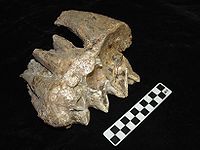- Coats-Hines Site
-
The Coats-Hines Site is an archaeological site located in Williamson County, Tennessee in the Southeastern United States. The site is significant in that it is one of only a very few sites in Eastern North America that contains direct evidence of Paleoindian[1] hunting of late Pleistocene proboscideans.[2] Excavations at the site have yielded three mastodon skeletons, including one in direct association with Paleoindian stone tools. This site was listed on the National Register of Historic Places on July 12, 2011.
Contents
Site Summary
The Coats-Hines site is located east of I-65 near CoolSprings Galleria in Williamson County, Tennessee. The site was initially recorded in 1977 when several large bones were identified during landscaping at the Crockett Springs Golf Course (now the Nashville Golf & Athletic Club). Salvage work by staff from the Tennessee Division of Archaeology recovered the partial skeleton of a single mature female mastodon (“Mastodon A”) from along a small stream drainage. No description of this excavation or the skeletal material was ever published, and the area that contained the remains was subsequently destroyed by earthmoving along the 13th hole of the golf course.[3]
In 1994 construction of a subdivision just west of the golf course by Hines Interest LP, resulted in identification of a well-preserved bone bed of Pleistocene-aged faunal material. The bone bed was situated 20 meters (65 feet 7 1⁄2 inches) west of the original mastodon find along a deeply-incised portion of the same stream channel, approximately 2 meters (6 feet 6 1⁄2 inches) below ground surface. Salvage excavations resulted in the identification of several late ice age species including horse, deer, muskrat, and the partial, disarticulated remains of a young male mastodon (“Mastodon B”) [2] The remains of a third mastodon (“Mastodon C”) were identified eroding from the bank line approximately 50 m west of Mastodon B, but were not excavated.
The results of the 1994 excavations were published in both Tennessee Conservationist[4] and the scholarly journal Current Research in the Pleistocene.[2] The site was assigned state number 40WM31, and named “Coats-Hines” in honor of Tennessee Division of Archaeology staff member Patricia Coats, who participated in the excavation of Mastodon A, and the Hines corporation, which facilitated the 1994 salvage work. Following excavations, the area that contained Mastodon B was backfilled and incorporated into the backyard of a single-family home.
Although Tennessee Division of Archaeology staff continued to conduct occasional inspections of the stream drainage, no additional excavations took place at the Coats-Hines site until 2008. That year, limited excavations were performed in order to recover several heavily fragmented bones eroding from the bank line at the location of Mastodon C. Poor preservation of the material prevented conclusive identification of the animal’s species, sex, or age [5]
Additional site inspections of the stream channel in 2008 resulted in the recovery of a bifacial stone tool and a highly mineralized fragment of deer antler. Both these artifacts had been eroded from their original context and could not conclusively be associated with the Pleistocene bone bed. However, staff from the East Tennessee State University and General Shale Brick Natural History Museum concluded that the antler fragment exhibited an extreme level of mineralization suggesting at least a late Pleistocene origin [5]. This find is noteworthy in that Pleistocene deer have only been recorded at twelve other sites in Tennessee.[3]
Paleoindian-Mastodon Association
During the 1994 excavations of Mastodon B, archaeologists identified 34 stone tools in association with the disarticulated faunal remains. These tools included prismatic blades, scrapers, gravers, and resharpening flakes. Subsequent examination of the bones from Mastodon B revealed the presence of cut marks on a thoracic vertebra which was recovered in direct contact with several flakes. The distinctive linear v-shaped profile of the cuts and their location along the thoracic spinous process indicates they are the result of butchering, and specifically efforts to remove dorsal muscles along the backbone [2].
Geoarchaeological analysis of soils from the 1994 excavations indicate that at the end of the Pleistocene epoch, the area which includes Mastodons A, B, and C was situated along the margins of a shallow pond. In the initial site analysis, Breitburg et al.[2] suggest this pond formed as a result of a beaver dam or other natural blockage along the stream channel. Numerous animals including mastodon would have congregated at this pond, thereby drawing the attention of Paleoindian hunters.
See also
- Mastodon
- Paleoindian
- List of archaeological sites in Tennessee
- History of Tennessee
- Tennessee Division of Archaeology
Notes and references
- ^ Although the Wikipedia entry for Paleoindian inserts a hyphen into the word, accepted scientific and archaeological nomenclature omits this punctuation
- ^ a b c d e Breitburg, Emmanuel; Broster, John B.; Reesman, Arthur L.; Strearns (1996), "The Coats-Hines Site: Tennessee’s First Paleoindian-Mastodon Association", Current Research in the Pleistocene 13: 6–8
- ^ a b Corgan, James X. and Emanuel Breitburg (1996): "Tennessee’s Prehistoric Vertebrates." State of Tennessee Department of Environment and Conservation Division of Geology Bulletin 84, Nashville.
- ^ Breitburg, Emmanuel; Broster, John B. (1995), "A Hunt for Big Game: Does Coats-Hines Site Confirm Human/Mastodon Contact?", The Tennessee Conservationist 61 (4): 18–26
- ^ a b Tune, Jesse W., and Aaron Deter-Wolf (2007): "New Finds of Old Bones at the Coats-Hines Site (40WM31)." Paper presented at the 21st annual Current Research in Tennessee Archaeology Meeting, Nashville.
Resources
Categories:- Archaeological sites in Tennessee
- Tennessee-related lists
- Mastodons
- Pleistocene mammals
- Megafauna of North America
- Prehistoric elephants
- Geography of Williamson County, Tennessee
Wikimedia Foundation. 2010.

